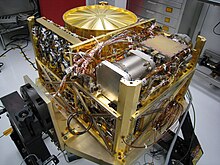Sample Analysis at Mars (SAM) is a suite of instruments on the Mars Science Laboratory Curiosity rover. The SAM instrument suite will analyze organics and gases from both atmospheric and solid samples.[1][2] It was developed by the NASA Goddard Space Flight Center, the Laboratoire des Atmosphères Milieux Observations Spatiales (LATMOS) associated to the Laboratoire Inter-Universitaire des Systèmes Atmosphériques (LISA) (jointly operated by France's Centre national de la recherche scientifique and Parisian universities), and Honeybee Robotics, along with many additional external partners.[1][3][4]

The SAM suite consists of three instruments:
The SAM has three subsystems: the 'chemical separation and processing laboratory', for enrichment and derivatization of the organic molecules of the sample; the sample manipulation system (SMS) for transporting powder delivered from the MSL drill to a SAM inlet and into one of 74 sample cups.[1] The SMS then moves the sample to the SAM oven to release gases by heating to up to 1000 °C;[1][8] and the pump subsystem to purge the separators and analysers.
The Space Physics Research Laboratory at the University of Michigan built the main power supply, command and data handling unit, valve and heater controller, filament/bias controller, and high voltage module. The uncooled infrared detectors were developed and provided by the Polish company VIGO System.[9]